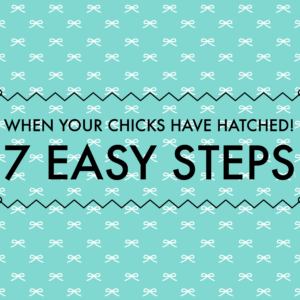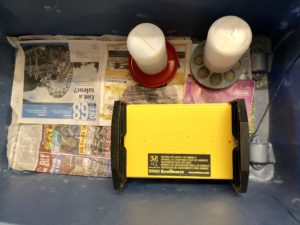When Your Chicks Have Hatched, 7 Easy Steps

So your chicks have hatched! What next? You will need the following supplies: Large Rubbermaid Bin, at least 20”x 34”, without lid; Newspaper; Clip-on Brooder Heat Lamp OR Brinsea Ecoglow*; Chick Feeder; Chick Waterer. This is for hatches of 10-12 chicks or LESS.
1. Spread newspaper on bottom of bin. I like newspaper because it’s free and is easy to change. You should replace soiled newspaper at least every 2-3 days.
2. Firmly attach heat lamp to side of bin with lamp directly over inside of bin or place Ecoglow along the inside of the bin. Plug cord into electrical outlet. *As I mentioned in “8 Steps to Perfect Chick Hatching”, I prefer the Ecoglow because it is safer than the Lamp. As the chicks grow they will become much more active and adventurous, climbing and flying. They can potentially knock the heat lamp down. This happened to a friend of mine and she came home to find a fire in her coop. Not good! Also, the Ecoglow is much cheaper to run and will save you money in the long run, especially if you are planning multiple hatches. Another plus to the Ecoglow is that it has three adjustable heights: lowest for newborns, medium at around two weeks old, and the top height when they reach four weeks.

3. Fill the chick waterer and chick feeder and place near the Ecoglow. Newborn chicks need quick access to food and water. Later, you can move these further away to help maintain cleanliness. 24-36 hours after hatching, move the chicks from the incubator to the bin, ensuring they are beneath the heat lamp or Ecoglow. You may need to adjust the height of the heat lamp: if the chicks are snuggled tightly together and crying it may be too high. If they are scattered on the outskirts away from the heat lamp it may be too low. Happy chicks may peep and bustle about but will not cry. Make sure that chicks understand how to drink; you may need to dip their beaks gently into the water at first. Usually, once one or two chicks have mastered this, the others will imitate them.
4. Frequently check your chick’s bottom for “pasty butt”, a condition where poop builds up in a hard little clump on the feathers surrounding the chick’s vent and prevents further pooping. This can result in death. Gently remove the poop clump using a soft cloth and some petroleum jelly or mineral oil.
5. Keep chicks in the bin for 4-6 weeks, at least until the feathers covering their undersides have come in, before moving them to a bigger coop.